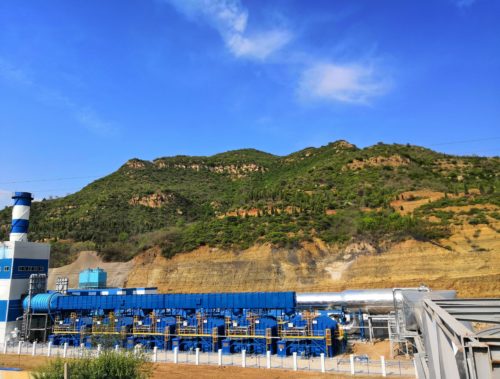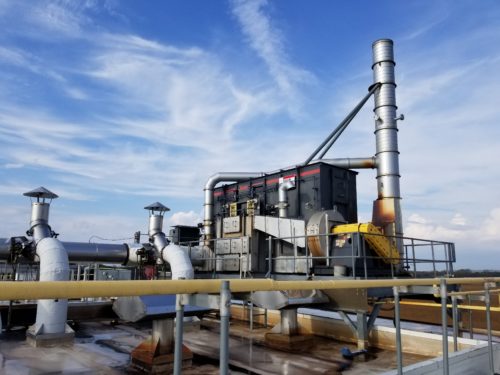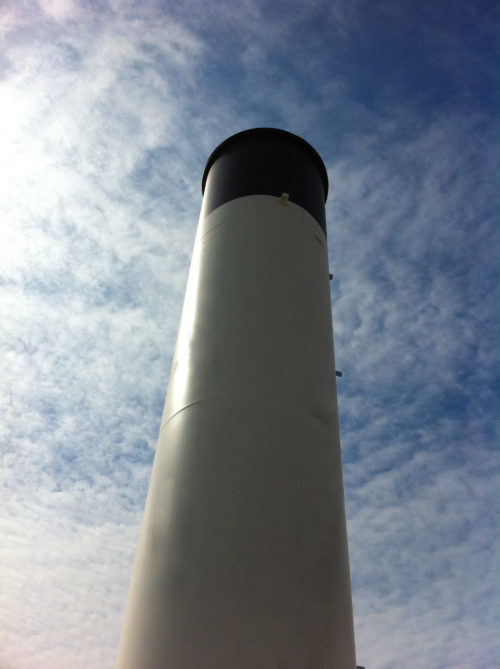Has a regulatory agency announced regulations in your industry or declared your workplace unhealthy? Do your neighbors complain about odors? Do you face the dilemma of balancing company profitability with the demand to meet environmental requirements?
 This guide will provide a general overview of air pollution control. It will also help you understand the various pollution control technologies and prepare you to make informed, knowledgeable decisions. All defined terms can be found in the Definitions section. Be sure to visit the Overview of Emission Control Technologies page once you are comfortable with the concepts discussed here.
This guide will provide a general overview of air pollution control. It will also help you understand the various pollution control technologies and prepare you to make informed, knowledgeable decisions. All defined terms can be found in the Definitions section. Be sure to visit the Overview of Emission Control Technologies page once you are comfortable with the concepts discussed here.
Before we begin, it is important to point out that many distinctly different industries have very similar pollution control challenges and also solutions. It is our goal at Anguil to utilize our experiences in every industry to help customers apply the proper technology on their specific application. Always feel free to contact an Anguil Representative near you to discuss your unique destruction requirements, efficiency demands and process parameters.
Answers to the questions below are broken down into manageable sections.
- What is the difference between Actual Cubic Feet per Minute (ACFM) and Standard Cubic Feet per Minute (SCFM)? How are they calculated?
- What are Volatile Organic Compounds (VOCs)?
- What are Hazardous Air Pollutants (HAPs)?
- What is thermal oxidation and how is it different from catalytic oxidation?
- How do I decide which technology to use?
- Basic definitions
What is the difference between Actual Cubic Feet per Minute (ACFM) and Standard Cubic Feet per Minute (SCFM)? How are they calculated?
ACFM and SCFM are units for volumetric airflow rates often used in determining size of an air pollution control device or energy recovery system.
ACFM is a measure of the actual volumetric air flow rate at the conditions of the air stream. The density of air varies with temperature and pressure. SCFM is a measure of the volumetric flow rate if the air stream were at standard conditions. Standard conditions are defined as 70°F and 1 atmosphere pressure. For metric users, ACFM is the equivalent of m3/hr (cubic meters per hour) and SCFM correlates to Nm3/hr (normal cubic meters per hour). Nm3 equals SCFM divided by 1.71928, dividing that number by 60 will then give you per minute comparison of feet and meters.
Here is how you would convert 5,000 ACFM of air at 230°F and 1 atmospheric pressure to SCFM. The ideal gas law tells us the relationship between air temperature and air density is directly proportional. Therefore we can convert ACFM to SCFM using the temperature ratio (absolute temperature).
SCFM = ACFM * (standard condition absolute temperature) / (actual absolute temperature)
SCFM = 5,000 * (70 + 460) / (230 + 460)
Therefore 5,000 ACFM of air at 230°F and 1 atm = 3,841 SCFM. The equation can be rearranged to convert SCFM to ACFM. The ideal gas law also tells us that pressure and temperature are directly proportional. A similar conversion is used to adjust to standard pressure.
What are Volatile Organic Compounds (VOCs)?

Some organic compounds are liquids that require an additional process like heating or cooling to create vapor, these are considered stable compounds. An organic compound is considered volatile if it vaporizes (forms a gas) at room temperature and normal atmospheric pressure. An example of this would be the fumes you see on gas pumps without a vapor recovery nozzle. Some of these vapors are dangerous to humans when inhaled in great quantities or over a long period of time. Some volatile organic compounds interrupt and destroy natural plant processes; however, many of the volatile compounds play a significant role in the formation of ozone and smog.
Ozone is three oxygen atoms bonded together to form O3. It does occur naturally in our environment but the introduction of large amounts of VOCs into our lower atmosphere (the air closest to us) has caused an unhealthy amount of ozone to be created. Oxygen + VOCs + Sunlight + Combination of complex reactions lead to the formation of ozone.
In the earth’s upper atmosphere, ozone is an important layer that protects the earth from the sun’s ultraviolet rays. But closer to the earth, ozone is a dangerous compound. It mixes with other compounds in the air and becomes the main component of smog. Smog is more than an ugly brown cloud hovering over the cities of the world. Smog causes respiratory ailments and heart conditions; it destroys agriculture and forests. In short, smog damages our entire environment.
The best way to prevent the increase in ozone and smog is to eliminate these harmful VOCs from being released. Anguil’s oxidation technologies are designed to do just that.
What are Hazardous Air Pollutants (HAPs)?
A Hazardous Air Pollutant (HAP) is a VOC that has additional harmful properties. The effects of HAPs are even more severe than VOCs. According to the U.S. Environmental Protection Agency, HAPs cause thousands of cancer deaths each year in the U.S. They can cause birth defects, nervous system damage and, during massive accidental releases, death.
HAPs also cause serious environmental damage. Fortunately, pollution control technologies can capture and destroy HAPs before they are released into the atmosphere. Again, the most effective destruction of HAPs and VOCs is accomplished by oxidation.
What is thermal oxidation and how is it different from catalytic oxidation?

Cn H2m + (n + m/2) O2 → n CO2 + mH2O + Heat
In the thermal oxidation process, the contaminated air is heated, breaking apart the bonds of the contaminated compounds. The molecules will reform naturally, bonding into carbon dioxide and water vapor and releasing energy, which is the basic premise to all forms of oxidation. However, during catalytic oxidation the contaminated compounds in the air react with a catalyst material (platinum, palladium, rhodium, etc.) which breaks apart the contaminated compounds at a lower temperature.
Thermal oxidation requires high temperatures to break apart the compounds. The large amounts of fuel needed to maintain high temperatures can be expensive. Different pollution control technologies help reduce the operating costs of the equipment. Catalysts, for example, react and oxidize the VOCs at a lower temperature, meaning less fuel and lower costs.
No matter which oxidation technology is best suited for your application, the “three T’s” of oxidation always apply: Temperature, Time, and Turbulence.
Temperature: Destruction temperature is determined by the VOCs in the air stream. Each compound has a different temperature at which the molecules are broken apart and oxidized.
Time: Time relates to how long a compound needs to be at a certain temperature in order for it to be oxidized. For example, benzene requires a temperature of 440ºF and a residence time of 0.24 seconds for 99% destruction in a catalytic oxidizer. In a thermal oxidizer, benzene needs 1460ºF and a residence time of 1.0 seconds for 99% destruction.
Turbulence: Turbulence is a fixed condition built into the equipment design. It ensures a proper mixture of VOCs and oxygen for combustion.
A successful technology achieves full oxidation of VOCs by maintaining the proper mixture of oxygen and contaminants at the required temperature for a sufficient amount of time.
Metal heat exchangers can also be added to thermal and catalytic oxidizers to recover or recup between 50% and 75% of the heat required for oxidation. Another system advance is the Regenerative oxidizer, which uses ceramic heat recovery media to capture and reuse as much as 95% to 97%+ of the heat from oxidation. The Rotor Concentrator is another unique approach to reducing long-term costs. By absorbing and then desorbing or concentrating the VOCs into a smaller airflow, the Rotor Concentrator allows for the smallest oxidizer possible.
The secret is to determine which technology works best and most cost effectively in each application.
How do I decide which technology to use?
In general, the selection process is dependent on these three criteria:
- Airflow (SCFM or Nm3/hr)
- Contaminants (VOCs) in the airflow
- Concentration of contaminants in the airflow, also called the percent Lower Explosive Limit (LEL)
After the rate and content of your exhaust airflow are analyzed, the proper technology selection can be made. Hopefully the explanations above and definitions below will help you to better understand your application. If we can answer any questions about this material or your application, please contact Anguil Environmental Systems.
Basic Definitions
ACFM: Actual Cubic Feet per Minute. Flow conditions with temperature and atmospheric conditions accounted for.
Catalyst: Substance that increases the rate of a chemical reaction without itself being consumed in the reaction.
HAPs: Hazardous Air Pollutants are VOC emissions with additional harmful properties.
Hydrocarbon: Compound found in all organic compounds. It is the bond that is broken during oxidation.
Incineration: Also known as oxidation but generally refers to solid waste destruction.
LEL: Lower Explosive Limit. The VOCs in your air stream have a known explosive limit. The explosive limit is the lowest organic concentration in a stream that would yield a combustible mixture in the presence of an ignition source. It is an essential factor in characterizing your process stream.
Recuperative: An oxidation technology (thermal recuperative or catalytic recuperative) that uses a plate, shell and tube, or other conventional type of metal heat exchanger to heat incoming air with air from the oxidation process. Recuperative systems can often recover 50% to 75% of the heat generated by oxidation.
Regenerative: An oxidation technology that uses two or more ceramic heat transfer beds that act as smaller heat exchangers and a retention chamber where the organics are oxidized. It can often recover 90%-97%+ of the heat generated by oxidation.
Rotor Concentrator: An oxidation technology add-on that reduces air volume and increases VOC concentration. The process stream flows through a continuously rotating wheel impregnated with adsorbent. Here the VOCs are adsorbed and the clean air is exhausted into the atmosphere. The wheel is then regenerated by passing through a stream of warm, low volume desorption gas that produces a concentrated stream that can be more efficiently destroyed by an oxidizer.
SCFM: Standard Cubic Feet per Minute. Flow conditions at standard conditions; usually defined at 70º F, sea level and one atmosphere.
VOCs: Volatile Organic Compounds: Organic chemicals that exist as vapor in air and that react in the atmosphere with nitrogen oxides in the presence of sunlight to form ozone (O3).
Emission Control Technologies
A VOC Handbook.
By Gene Anguil / Founder & CEO of Anguil Environmental Systems, Inc.
This handbook was originally written by Gene Anguil as a chapter in the Odor and VOC Control Handbook by Harold J. Rafson (Editor). It has recently been updated for publication on our website to reflect technology advances and terminology changes.

